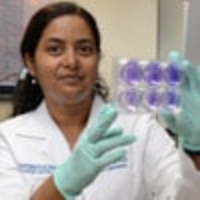Moving space-matter as the basis of the intelligence in the Physical World
Published on: 28th March, 2019
OCLC Number/Unique Identifier: 8188232631
The concept of space-matter motion in the new Cartesian physics, based on the identity of space and matter, creates the basis for the study of consciousness as the action of the brain in space inside and outside itself and offers a way of materialistic explanation of life on Earth. She claims that consciousness in living matter arises when the brain begins to create the surrounding space the image of themselves and the world. And since space according to Descartes is identical to matter, the images created by the brain of itself and the external world in the surrounding space have a material basis and therefore the displayed organs interact with each other and the external world.
Gravitation - Flat Power Field
Published on: 30th October, 2018
A new principle of origin and the nature of the action of gravity forces are proposed. Forces of universal attraction have plane-symmetrical directions. On this basis, it becomes possible to reconsider certain regularities in natural science. The new principle of gravitation will allow to explain physical paradoxes, to improve methods of scientific research and some technological processes.
Sounding procedure for characterization of big fusion reactor chambers by means of a compact neutron source with a nanosecond pulse duration
Published on: 20th September, 2018
OCLC Number/Unique Identifier: 7900044986
In the paper a methodology that is elaborated for characterization of big-sized chambers of modern and future nuclear fusion reactors is described. It gives an opportunity to define distortions introduced by surroundings, systems and elements of the chamber into the neutron field generated during the reactors’ operation. The procedure is based on two types of experimental techniques supported by MCNP numerical modelling. These two classes are: 1) the neutron activation methods for measuring changes in anisotropy of the “absolute” neutron yields, and 2) the time-of-flight process for determination of neutron spectra deformations. MCNP calculations afterwards give an opportunity to fix just those elements of the surroundings that introduce the main impact in the perturbed neutron field characteristics.
Magnetohydrodynamic CNTs Casson Nanofluid and Radiative heat transfer in a Rotating Channels
Published on: 17th August, 2018
OCLC Number/Unique Identifier: 7821244476
The main purpose of this investigation is to inspect the innovative conception of the magneto hydrodynamic (MHD) nanoparticles of single wall carbon nanotubes base on the fluids (water, engine oil, and ethylene, glycol and kerosene oil) between two rotating parallel plates. Carbon nanotubes (CNTs) parade sole assets due to their rare structure. Such structure has significant optical and electronics features, wonderful strength and elasticity, and high thermal and chemical permanence. The heat exchange phenomena is deliberated subject to thermal radiation. Kerosene oil is taken as based nano fluids because of its unique attention due to their advanced thermal conductivities, exclusive features, and applications. The fluid flow is presumed in steady state. With the help of suitable resemblance variables, the fundamental leading equations have been converted to a set of differential equations. To obtain the solution of the modeled problem, the homotopic approach has been used. The influence of imbedded physical variables upon the velocities and temperature profiles are defined and deliberated through graphs. Moreover, for the several values of relevant variables, the skin fraction coefficient and local Nusselt number are tabulated. Plots have been presented in order to examine how the velocities and temperature profile get affected by various flow parameters.
High energy HF (DF) lasers
Published on: 17th August, 2018
OCLC Number/Unique Identifier: 7821292396
Non-chain HF (DF) lasers are the most suitable and ecologically safe source of powerful and energetic coherent radiation in the 2.6-3.1 cm (HF laser) and 3.5-4.1 cm (DF laser) spectral regions. Among the different methods of HF (DF) pulse and pulse-periodic laser creation suggested by our team under the guidance of Academician A.M. Prokhorov was self-sustained volume discharge (SSVD). It is well known that a SSVD can be established in a gas by creating a primary electron density that exceeds a certain minimum value nmin throughout the discharge gap.
Best and effective practices of wound care and healing among patients with Diabetes Mellitus
Published on: 19th December, 2018
Aim: With the continuing trend in the incidence of diabetic ulcer, the current researches on wound care and healing will bring best and effective practices on wound care and healing among patients suffering from diabetes mellitus.
Methods: This study utilized a systematic review of literatures in light of wound care through Pub Med database with the key words “Diabetes Mellitus,” “wound practices,” “wound healing,” and “systematic review.” The searched literatures were of case reports, interventional studies, and review papers whose main texts were in English.
Results: There were 7,988 published articles yielded from the keywords used and 16 were included in this study. The practiced management and techniques in these literatures focused on comfortable and cost efficient means of wound care and healing with the involvement of group participation than individual plan of care.
Conclusions: There are meager evidences of feasible wound and healing options that needs further studies in resolving wound issues among patients with Diabetes Mellitus. This systematic review establishes the insufficiency of high level of evidence based studies on wound healing in DM patients and brings a track for continuity of rigid studies concerning this topic.
Effect of spiritual health (Sound Heart) on the other dimensions of health at different levels of prevention
Published on: 21st September, 2018
OCLC Number/Unique Identifier: 7900079184
Introduction and goal: From the perspective of Islam, spiritual health means having a Sound Heart (a calm, confident and optimistic soul, with hope for God’s mercy, satisfaction with destiny and vitality). The way to achieve spiritual health is strengthening the faith and taking good deeds based on religious spirituality. This study was conducted with the aim of determining the impact of spiritual health (Sound Heart) on the other aspects of health at different levels of prevention.
Methods: In nine phases of research in 16 years, after designing and validating the “Sound Heart Model”. The spiritual problems of patients and healthy clients were determined. Spiritual care guidelines and the spiritual counseling model in patients and healthy clients were designed. Then “Parent’s Spiritual Empowerment Program”, “inter-professional spiritual health care training program” was extracted. Based on the findings of the previous steps, the effect of spiritual health on other aspects of health at different levels of prevention was extracted.
Findings: Belief in God and divine love creates spiritual health (Sound heart) with wisdom, chastity, courage, justice, dignity, kindness, and sincerity in action. Faith prevents neglecting from the God’s remembrance and its consequences such as: unhealthy lifestyle, risky behaviors, destructive excitements, psychosocial diseases in clients and eliminates the fear, anxiety, sadness and disappointment in patients. Spiritual health causes living in the present time with patience and grace of God, creates hope, optimism for the future, courage to face life crises. By creating mental health, it improves the psycho-neuron-immunologic function and improves physical health.
Conclusion: Considering the great impact of spiritual health on the other aspects of health at all levels of prevention, it is imperative that students and health care staff, by referring to these concepts, carry out spiritual care/counseling.
Climate and garbage
Published on: 21st January, 2021
OCLC Number/Unique Identifier: 9031343389
Humanity has destroyed 70% of the land by arable land, reservoirs, asphalt, concrete, garbage and ore landfills.
Each of us sends 400-500 kg of garbage to the landfill per year. If from the garbage that the inhabitants of Russia throw out in a year, they built a tower with an area of one meter by one meter, then it would be possible to get to the Moon through it: https://greenpeace.ru/wp-content/uploads/2019/10/report-RUSSIA -GARBAGE.pdf
The area of the world’s landfill on land is the size of Mexico, and it is growing.
Industrial control systems: The biggest cyber threat
Published on: 4th December, 2020
OCLC Number/Unique Identifier: 8872698359
Industrial control systems (ICS) are critical, as in these systems, cyber threats have the potential to affect, disorganize, change their mode of operation, act as an information extraction vehicle, and ultimately turn against itself. Creating risks to the system itself, infrastructure, downtime, leakage of sensitive data, and even loss of human life. Industrial control systems (ICS) are vital to the operation of all the modern automated infrastructure in the western world, such as power plant and power stations. Industrial control systems (ICS) differ from the traditional information systems and infrastructures of organizations and companies, a standard cyber security strategy cannot be implemented but part of it adapting to the real facts and needs of each country, legislation and infrastructure. These systems require continuous operation, reliability and rapid recovery when attacked electronically with automated control, isolation and attack management processes. Incorrect settings and lack of strategic planning can lead to unprotected operation of critical installations, as they do not meet the cyber security requirements. Industrial control systems (ICS) require special protection in their networks, as they should be considered vulnerable in all their areas, they need protection from cyber attacks against ICS, SCADA servers, workstations, PLC automations, etc. Security policies to be implemented should provide protection against cyber threats, and systems recovery without affecting the operation and reliability of operating processes. Security policies such as security assessment, smart reporting, vulnerability and threat simulation, integrity control analysis, apply security policy to shared systems, intrusion detection and prevention, and finally firewall with integrated antivirus and sandbox services should be considered essential entities.
Women’s Mental Health and Mental retardation
Published on: 4th September, 2018
Mental illness is associated with a significant burden of morbidity and disability. Lifetime prevalence rates for any kind of psychological disorder are higher than previously thought, are increasing in recent cohorts and affect nearly half of the population. Overall rates of psychiatric disorder are almost identical for men and women but striking gender differences are found in the patterns of mental illness. Gender is a critical determinant of mental health and mental illness. Gender differences occur particularly in the rates of common mental disorders - depression, anxiety and somatic complaints. These disorders, in which women predominate, affect approximately 1 in 3 people in the community and constitute a serious public health problem [1].




